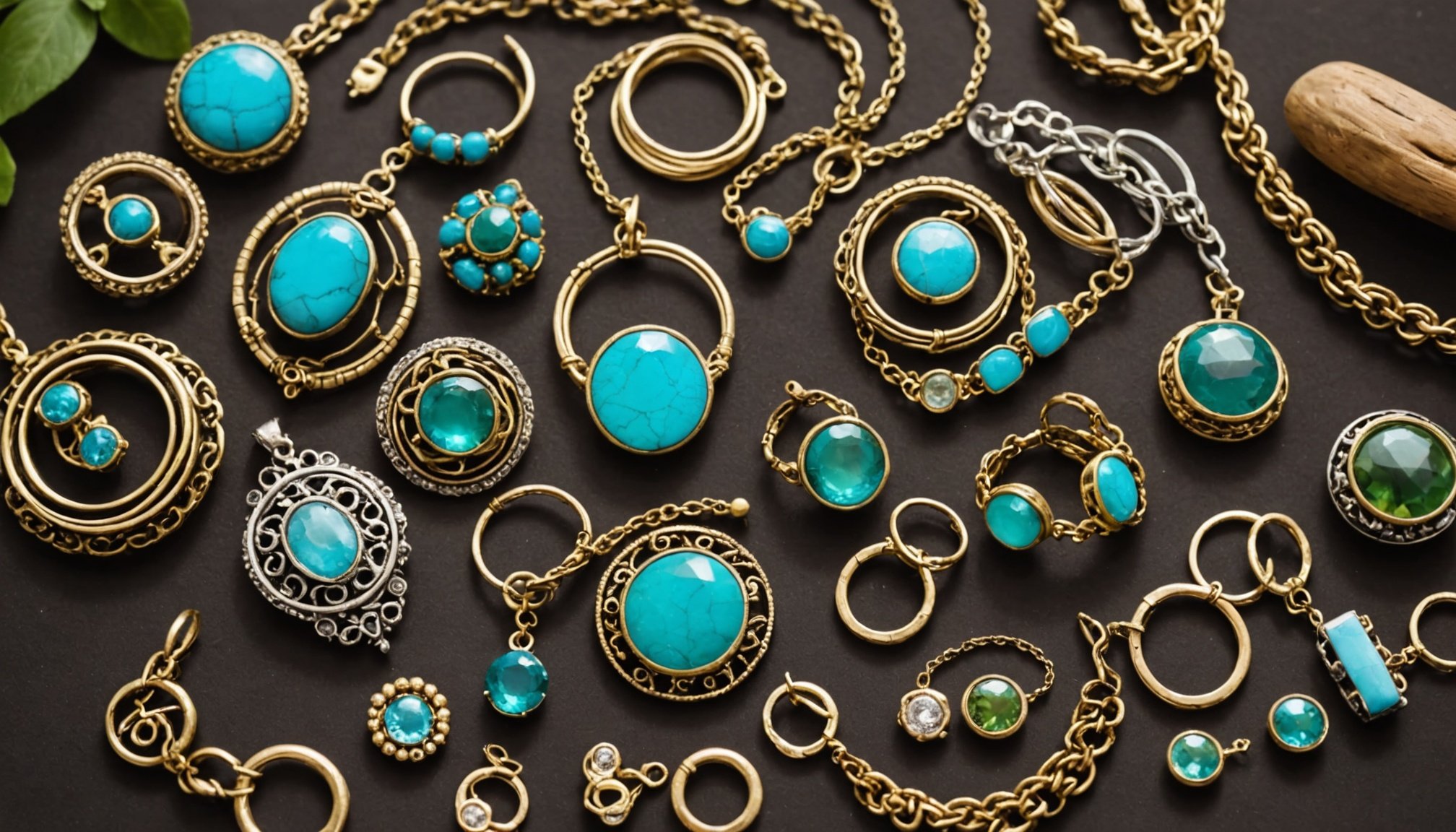Understanding Eco-Friendly Jewelry
Eco-friendly jewelry is an emerging trend that prioritizes sustainable practices and minimizing negative effects on the environment. As consumers become increasingly eco-conscious, the demand for jewelry made from recycled or ethically sourced materials is on the rise. This type of jewelry minimizes the destruction and pollution typically associated with conventional mining practices.
In the traditional jewelry industry, the environmental impact can be severe, involving deforestation, toxic waste production, and extensive water usage. Conventional mining and extraction methods contribute to soil degradation, water pollution, and loss of biodiversity. On the other hand, eco-friendly jewelry seeks to counteract these issues by adhering to guidelines that reduce the carbon footprint, choose fair labor practices, and use renewable resources.
Also read : Eco-Friendly Ways to Dispose of Skincare Packaging: Your Ultimate Guide to Sustainable Practices
The growing demand for sustainable and ethical practices has encouraged many brands to innovate and adopt greener methods. These companies use alternative materials, such as recycled metals and conflict-free gemstones, to create beautiful yet environmentally responsible products. By opting for eco-friendly jewelry, consumers can support a shift towards a more conscientious industry, prioritizing both style and sustainability. This movement towards green options also spreads awareness, encouraging further advancements in environmental impact management within the jewelry sector.
Key Materials Used in Eco-Friendly Jewelry
Eco-friendly jewelry prioritises using sustainable materials, ensuring an ethical impact on the environment and communities involved. A prominent component of such jewelry is recycled metals. These metals, often sourced from discarded electronics or industrial waste, significantly reduce the need for new metal mining. This not only conserves natural resources but also diminishes global greenhouse gas emissions, enhancing environmental sustainability.
In parallel : Top Eco-Chic Bags to Embrace This Spring: Your Ultimate Guide to Sustainable Fashion
In addition to recycled metals, ethical gems form a core part of eco-friendly jewelry. These gemstones are sourced through methods that respect human rights and the environment. Ethical gemstone sourcing prevents the support of exploitative practices often seen in traditional mining sectors, promoting fair wages and safe working conditions.
The benefits of utilizing sustainable materials in jewelry production extend beyond environmental preservation to also include economic and social advantages. By opting for ethical gems and recycled metals, consumers contribute to a system that prizes transparency and equity.
Lastly, some innovative jewelers integrate organic materials like fair trade wood or lab-grown diamonds, further pushing the boundaries of sustainable practices. These choices ensure that both the planet and its inhabitants reap the benefits of eco-conscious craftsmanship, making each piece of jewelry not just a statement of style, but also a testament to sustainable values.
Sourcing Transparency and Brand Values
The modern market is buzzing with brand transparency and a call for businesses to embrace ethical practices comprehensively.
Importance of Transparency in Sourcing
Transparency in sourcing lays the foundation for a brand’s corporate responsibility. It’s not just a trend but a prerequisite for maintaining trust and integrity. When companies openly share their sourcing strategies, they allow consumers to make informed decisions based on clear data.
Aligning Brand Values with Personal Values
Brand values that reflect ethical consumerism can forge powerful connections with their audiences. Customers are increasingly drawn to brands that echo their personal beliefs, such as sustainability and fairness. Aligning corporate responsibility with personal values is crucial for long-term loyalty.
Evaluating a Brand’s Commitment to Sustainability
- Information Disclosure: A hallmark of a truly accountable brand is how extensively it discloses sourcing information.
- Ethical Consumerism: Look for brands promoting fair working conditions and eco-friendly practices.
- Sustainable Commitment: Indicators include environmental impact reports and partnerships with ethical organisations.
The significance of transparency isn’t just about meeting consumer demands; it’s about securing a brand’s place as a genuine leader in a progressively conscious market. Understanding these principles empowers consumers to choose brands that prioritize ethical practices and corporate responsibility.
Certifications and Standards in Eco-Friendly Jewelry
Navigating the world of eco-friendly jewelry can be daunting, but understanding sustainability certifications and ethical standards is crucial. These certifications act as a stamp of approval, letting consumers know the jewelers adhere to strict environmental and ethical practices.
Eco-labels like the Fairmined Standard ensure that the jewelry is sourced responsibly, considering the welfare of both the environment and the workers involved. When a brand meets these recognized standards, it not only demonstrates its commitment to sustainable practices but also offers consumers peace of mind.
Choosing brands with these certifications is important because it adds credibility and instills assurance. Certifications act as a bridge of trust between the brand and the consumer, providing clear evidence that the materials used are sustainable and ethically sourced.
In essence, these eco-labels give consumers the power to make informed choices, turning the purchase of jewelry into an opportunity to support ethical practices. This responsibility resonates with many, as consumers increasingly value transparency and sustainability in their purchases. By investing in certified eco-friendly jewelry, buyers contribute to a larger movement towards a sustainable future in the industry.
Manufacturing Processes and Environmental Impact
Understanding the manufacturing processes is vital for appreciating the environmental impact of a product. Ethical manufacturing practices and low-impact processes are essential considerations in this sphere.
Eco-friendly manufacturing techniques
Several companies adopt eco-friendly techniques to reduce their carbon footprint. Techniques such as using renewable energy sources, recycling materials, and reducing waste are crucial. These methods not only contribute to environmental sustainability but also enhance product quality by ensuring that fewer pollutants enter the ecosystem.
Assessing the brand’s production chain
Evaluating a brand’s entire production chain is necessary for understanding its ethical manufacturing commitments. This involves scrutinizing every stage, from sourcing raw materials to the final product assembly. Brands committed to low-impact processes often work with suppliers who adhere to strict environmental and ethical standards.
Comparing environmental impact with conventional processes
The relative benefits of eco-friendly methods over conventional processes can be significant. Conventionally manufactured products often have a larger carbon footprint, resulting in higher emissions and resource depletion. In contrast, ethical manufacturing aims to minimize these impacts by using low-impact processes that conserve resources and reduce waste.
Recognizing the importance of these practices can empower consumers to make choices that support sustainable development.
Benefits of Choosing Eco-Friendly Jewelry
Eco-friendly jewelry offers multiple advantages of sustainability, promoting a more conscious lifestyle. By choosing environmentally-friendly jewelry, wearers contribute to significant positive environmental impacts. Traditional jewelry production often involves extensive mining, which can lead to habitat destruction and pollution. In contrast, sustainable options utilize materials and processes that minimize such harm.
Supporting sustainable brands is crucial in influencing market trends. As consumer preferences shift towards ethical consumption, the demand for eco-friendly products encourages companies to adopt more responsible practices. This market influence leads to increased availability of sustainable choices, benefitting both people and planet.
Personal impact can be significant when opting for sustainable jewelry. Apart from environmental benefits, individuals experience the personal satisfaction that comes from supporting responsible businesses. This ethical consumption aligns with personal values and offers a sense of purpose, knowing their purchases contribute to a healthier world.
Not only do eco-friendly options meet aesthetic criteria, but they also accommodate the growing demand for social responsibility. With the rising awareness of environmental issues, the choice to opt for sustainable jewelry reflects an informed decision fostering personal and collective changes. Thus, eco-friendly jewelry stands as a beacon of ethical consumption, promoting positive transformations across the industry.











